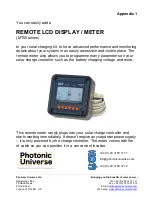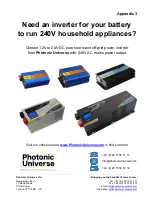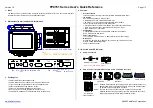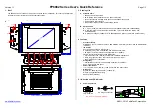
Photonic Universe Ltd
-
Bringing you the benefits of solar power -
Registered office:
Tel: +44 (0) 203 150 11 11
13 David Mews
Fax: +44 (0) 203 150 12 12
Porter Street
Email:
info@photonicuniverse.com
London W1U 6EQ UK
Web shop:
www.photonicuniverse.com
exposed to bright light, we recommend putting some cover on it before connection (for example the
carton box in which it came). Connect the solar panel cables to the solar terminals of the controller,
and then remove the cover from the panel.
Note: after connecting the solar panel, and with the panel exposed to some light, the LCD display on
the solar charge controller will show electricity flow from the solar panel to the battery. This means the
controller has started charging your battery.
4. If your solar kit is installed in the vehicle or boat or another system with a negative common ground,
do not use any earthing or grounding
of the solar panel or load cables.
5. For other electrical installation details and information on how to operate and use the solar charge
controller, please refer to the instruction manual for the solar charge controller.
6. This MPPT controller also has load terminals. Connecting a load (e.g. LED lights) is not necessary,
but if you would like to connect it, please take note the following:
-
The load operating voltage should be the same as the battery voltage
-
Connection must be made via an in-line fuse with the current rating not higher than 20A
-
In addition to the manual setting mode for switching the load on/off, the controller can switch it
automatically by timer settings. Please refer to the controller user manual for full details.
-
Under no circumstances should an inverter or other powerful appliance be connected to the
load terminals of the solar charge controller.
To disconnect the system, the order of disconnection should be the reverse to connection.
You should
disconnect the solar panel and loads from the controller first
, and then disconnect the battery. It is
important that you follow this disconnection order if you need to remove or replace the battery.
Fitting the solar panel to your roof
1. Make sure all the components of your solar charging kit are disconnected when you start fitting the
solar panel.
2. Choose a location for the solar panel where it will be exposed to maximum sunlight and minimum
shading from nearby objects. Even a small shaded area can reduce the output significantly (e.g.
leaves, shade from buildings etc.)
3. Drill holes in each of the corner and side plastic brackets in the designated places.
4. Attach the brackets to the solar panel frame (corners and sides) and mark corresponding holes on the
frame.
5. Drill smaller holes in the solar panel frame, according to the diameter of self-tapping screws which
you are planning to use (the drill size should be smaller than the screw diameter, so that screws grip
well).
6. Using self-tapping screws, fix plastic brackets to the corners and sides of the solar panel frame.
7. Using an appropriate adhesive, bond the brackets with the solar panel to your roof (using the sand
paper and cleaning the surfaces for better grip if needed). To ensure that the polarity of the wires is
clear
, mark the “+” solar panel lead so that it is visible from the outside.
Note: when choosing the adhesive / bonding agent for your installation, make sure it is suitable for
outdoor use (e.g. suitable for a wide temperature range). For added strength, in addition to bonding
the brackets to the roof, you can drill a small vertical hole in each bracket and fix the brackets by self-
tapping screws (if the roof surface allows that). Sealant / adhesive should then be put on the top of
the screws to make the area waterproof.
8. Feed the solar extension cables through the cable entry gland, the hole in your roof and then bond the
gland to the roof. Tighten the cable gland nuts after the adhesive has dried.
Adding fuses to your system
Although the solar charge controller has battery protection functions, you can install fuses for the battery
and the load, for additional protection against short circuits and wiring mistakes. They should be inline
fuses between the solar charge controller and the battery, and between the controller and your load when

























